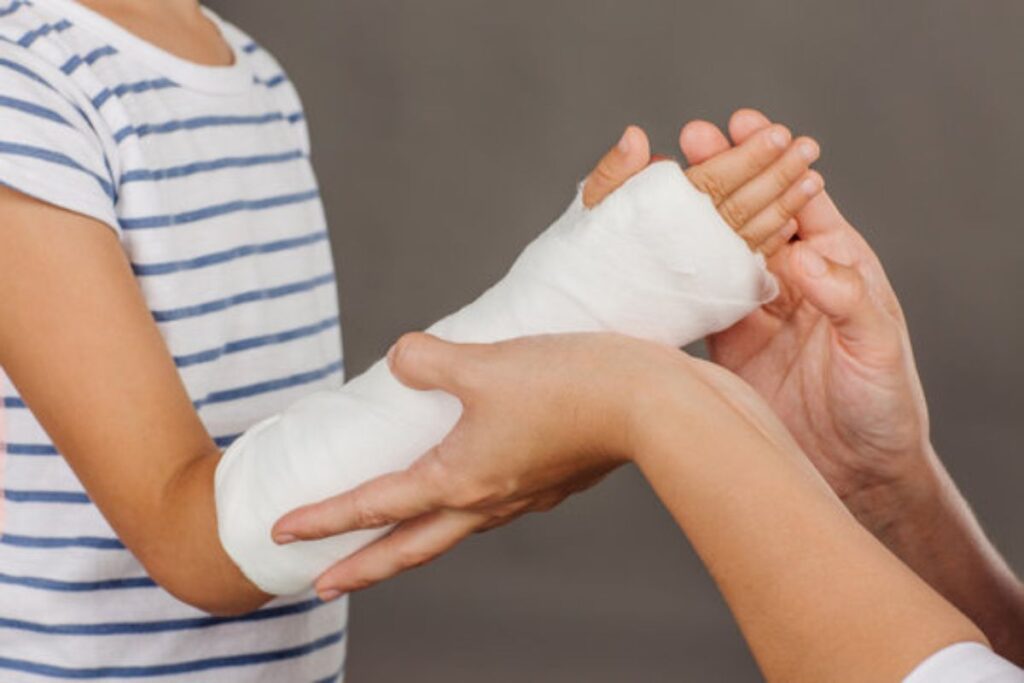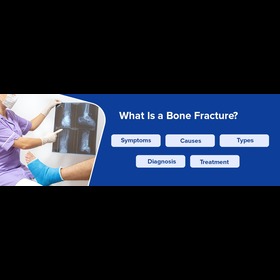
Children are naturally very active and prone to falls and minor injuries. However, a broken bone can be particularly distressing for both the child and their caregivers.
A broken bone, also known as a fracture, can happen due to falls, accidents, sports injuries, or other trauma. Prompt and proper care is essential to prevent complications and ensure proper healing. Every parent must know what to do if their child or a child around them suffers a broken bone.
What can be done if a child suffers a fracture?
Recognize the Signs of a Broken Bone
The first and foremost thing to ensure the right first-aid is to recognise a broken pain. Some common signs of broken bone include:
- Severe pain in the injured area
- Swelling and bruising of the injured area
- Deformity or unnatural angle of the limb
- Difficulty or inability to move the affected limb
- A snapping or grinding sound at the time of injury
- Numbness or tingling around the site of injury may be reported by older children (this could indicate nerve involvement)
If any of the above signs are present, then the parent or caregiver can be alerted about a possible bone injury, and it’s important to take the injury seriously.
Stay Calm and Ensure Safety
If the parent or caregiver recognises a bone injury, then the most important thing next is to stay calm. This enables them to take the right first steps for treatment. Here is what can be done:
- Move the person away from danger, but avoid moving the injured limb unnecessarily.
- If the injury is severe or the person is in shock, keep them lying down and calm while you take the next steps, like contacting a hospital.
- Do not try to realign the bone yourself; improper handling can worsen the injury.
- While transporting the child to the hospital, ensure that the fractured part is stable and rested at a comfortable spot, like a soft pillow.
Immobilize the Injury
In case of any delay in traveling to the hospital, caregivers can carefully stabilize the injured part for the comfort of the child. Here is what can be done:
- Use any firm object (like a board or rolled-up newspaper) to immobilize the injured area.
- Wrap the site gently with a soft bandage or cloth, ensuring it is secure but not too tight to restrict blood flow or cause further pain.
- If the fracture is in a limb, try to support it with a sling if possible.
Apply Ice
Do not give a hot compress or apply balm to that area, as it can cause swelling and pain; instead, apply an ice pack wrapped in cloth to the injured area intermittently while you take the child to the hospital. This helps reduce swelling and relieve pain.
However, avoid placing ice directly on the skin to prevent frostbite.
Manage Pain
Over-the-counter painkillers like acetaminophen or ibuprofen can help relieve pain till the child reaches the hospital. However, follow dosing instructions carefully and consider any allergies or health conditions before giving medication. It is recommended to call a hospital immediately and consult a pediatric orthopaedic surgeon regarding medication and dosage, while also alerting the hospital about the emergency.
Seek Medical Attention Immediately
While the above five points are important steps of first-aid, any parent or caregiver should attempt to take the child to the hospital at the earliest for the best care, and the right cure.
A pediatric orthopaedic specialist is the expert who should examine all suspected fractures. They are the ones who specialise in handling the growing bones of children. After an initial examination, the doctor would prescribe X-rays or other imaging, which are required to determine the type and severity of the fracture immediately.
Depending on the type and severity of the fracture, a treatment plan is suggested.
What could be the possible treatments for a fracture?
Depending on the fracture type, the treatments can be:
- Casting or splinting to hold the bones in place
- Surgery with the need for pin insertions in complex fractures to ensure the right alignment of bones.
- Physical therapy after healing to restore strength and mobility
Aftercare and Recovery from Fractures
Cast removal does not indicate the end of treatment for fractures; parents, caregivers, and children must care for the healing bone much beyond that to ensure strength and prevent re-injury of the fractured bones. Here is what can be done:
- Follow your doctor’s instructions for rest, immobilization, and gradual movement as instructed.
- Eat a diet rich in calcium and vitamin D to support bone healing.
- Avoid putting weight or pressure on the injured area until your doctor confirms it is safe.
- Attend all follow-up appointments to monitor the healing process.
When to Seek Emergency Help?
Call emergency services right away if you notice any serious signs such as severe bleeding, a bone protruding through the skin, loss of pulse, numbness, or inability to move the injured limb. Immediate help is also crucial in case of a head injury, multiple fractures, or signs of shock, such as pale or clammy skin, rapid heartbeat, or dizziness.
Why choose Ankura?
Ankura Hospital for Women and Children has the best team of pediatric orthopaedic specialists and general pediatricians who are committed to providing empathetic and quality care for babies and children. We offer the most advanced and world-class pediatric setup, where every child is treated with personalized care, clinical excellence, and compassion. Be it a regular consultation or advanced orthopaedic needs in children, our expert team ensures safe, accurate, and child-friendly procedures using the latest technology in a comforting environment.
At Ankura, we believe in a family-centered approach, ensuring parents are involved in every step of the care process. With state-of-the-art diagnostic tools, child-friendly facilities, and 24/7 pediatric support, Ankura remains a trusted destination for children’s overall health.
FAQ’s for Handling Broken Bones in Children: Key Signs and Treatments for Parents and Caregivers
If your child is unable to move the limb, the area is swollen, deformed, or extremely painful to touch, it may indicate a fracture. A medical evaluation and X-ray are needed to confirm it.
No. Do not attempt to realign or push a bone back into place. Instead, keep the injured limb as still as possible and support it with a splint or soft cloth until medical help arrives.
Keep your child calm and still. Apply a cold compress wrapped in a cloth to reduce swelling, and if possible, elevate the injured area. Avoid giving food or water in case surgery is required.
Children generally heal faster than adults. Most simple fractures take about 4–6 weeks to heal, though it may vary depending on the bone and the child’s age.
Ankura Hospital for Women and Children, which is spread across multiple locations in Hyderabad, has the presence of the best pediatric orthopaedic surgeons. Ankura is also located in Khammam, Vijayawada, Tirupati, Pune, and Bhubaneswar.
Author: Dr. Sujith Omkaram
Consultant Pediatric Orthopedician




